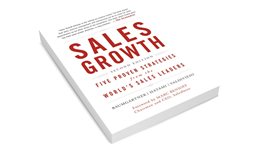“Do more for less.” If there were a tagline for sales in the past couple of years, that might be it.
Fueling the next wave of revenue and profit growth is a top priority for many sales leaders. As companies scale, however, traditional methods, such as adding more front-line sellers to expand account coverage or overlay sales capacity, often yield diminishing returns and are simply not practical in many resource-constrained industries. Sales leaders are simply expected to do more with less, in most cases.
At the same time, new trends are forcing sales leaders to rethink how they sell. Customers used to the simple purchase processes in the B2C world are expecting the same sort of experience with B2B companies. They’re demanding more self-service capabilities for product research, trial, and purchase, for example. Given that so much is available online, customers also have a higher bar for the depth of technical expertise on products and services that solution vendors bring.
Enter sales operations. A strong sales-operations function can address these issues and drive revenue growth by reducing the time reps spend on various administrative tasks, speeding up the sales process, and improving the experience for the customer. As McKinsey’s recent edition of its book Sales Growth: Five Proven Strategies from the World’s Sales Leaders highlights, focusing on process re-engineering, automation, and optimization of sales-support resources can also dramatically reduce the cost of sales.
In our experience, companies that build world-class sales-operations functions can realize one-time improvements of 20 to 30 percent in sales productivity, with sustained annual increases as high as 5 to 10 percent in some cases. Our research also shows that companies that invest one resource in sales support for every front-line sales resource drive significantly higher sales productivity than companies that invest less. Underinvesting in sales-support functions simply shifts the necessary transaction and administrative work to sellers, taking away time better spent with customers.
Unfortunately, not many companies have high-performing sales-operations functions. In our survey of more than 12,000 sales professionals from over 90 companies, we found that the median company demonstrates best practice on only 40 percent of identified sales-operations capabilities, and even top-quartile companies demonstrate best practice on only 60 percent. Moreover, while most companies would say that technology is an important lever in driving sales-performance improvement, our research shows that only 28 percent of survey respondents are using state-of-the-art sales technology in their sales-operations functions.
Would you like to learn more about our Marketing & Sales Practice?
What good looks like
So what do world-class sales-operations functions actually look like? These organizations deliver operational excellence day in and day out as well as being leaders in driving sales outcomes and change. World-class sales-operations teams consistently achieve budget, quota, and forecast while maintaining healthy pipelines. They proactively engage with sales managers and sellers to understand deal status and recommend actions to increase deal values, accelerate opportunities through the sales cycle, or improve win rates. And they maintain a tight focus on resource optimization, making the attraction, development, and retention of key talent a priority.
In leading companies, a strong sales-operations function also harnesses data and technology to deliver clear sales plans and insights that sellers can act on, create predictability and rigor in sales management, and drive adoption of new selling motions.
There are a wide range of important capabilities and management practices needed to drive a high-performing sales-operations program. Technology and automation, for instance, have a core role. Many companies, however, focus solely on technology investments and neglect the people, process, and organizational side of the equation.
In our experience, four hallmarks of the most successful modern sales-operations organizations stand out:
1. Focus on enabling your sellers
An emerging trend that we are seeing in several leading sales-operations organizations is the formalization of what many call a “sales enablement” or “sales effectiveness” role. It can be located in the corporate HQ and/or field locations and typically focuses on designing and implementing programs or process improvements that reduce the non-value-added work for sellers and provide them with insights and services that improve both the time spent with customers and the effectiveness of their interactions. These companies often have a very structured methodology for measuring how sales reps spend their time on customer-facing and administrative activities, data they use to set process-improvement and IT automation priorities. Examples of initiatives include account-planning reengineering, CRM simplification efforts, streamlined bid management, and proposal desks.
One of our clients has gone so far as to deploy sales-enablement resources in each of their operating geographies to ensure that local sales managers and individual sellers fully understand upcoming changes in sales processes and know how to use new sales tools to increase their individual productivity. When the company recently rolled out a new standard CRM system, each of the sales-enablement resources conducted observation sessions to take stock of current practices that might be disrupted by the new system, held workshops and “brown bag” events in the local subsidiaries to educate and answer questions, and in some cases sat side-by-side with reps to make sure they understood the new workflows and system functionality.
2. Take a leadership role
What sets the best sales-operations organizations apart is their influential leadership roles among their peers. In leading organizations, sales-operations leaders run the weekly, monthly, and quarterly pipeline, forecast, and business reviews, and hold their peers accountable for delivering against commitments. They lead account and territory planning clinics, and drive the annual and quarterly customer-segmentation, capacity-planning, rostering, and quota-setting processes for their entire geography or global segment. They harness the power of advanced analytics to provide deeper business insight that leads to better management decision making, front-line sales-rep targeting, or customer engagement, often leading changes in go-to-market models and sales management. In many of these leading companies, the sales-operations leader acts as the COO of the sales organization and the right-hand person to the senior sales leader.
Beyond leading the core sales processes to drive today’s results, world-class sales-operations teams also drive change and instill a culture of continuous improvement within the sales organization. Sales-operations leaders understand the company’s strategies and priorities, translate them into leading indicators, and track them via dashboards and scorecards to gauge how fast the organization is moving toward new sales motions, business models, and desired outcomes. They lead the charge in identifying areas for improvement—such as driving more effective channel-partner engagement or speeding up deal cycle times—and actively sponsor new processes and tools to drive consistent adoption of best practices across the organization. For example, the sales-operations organization at one of our clients drove the standardization of pipeline reporting across more than 80 subsidiaries, leading to significant optimization of shadow IT expense and reduction in time wasted by sales leaders in arguing over multiple versions of the truth.

Sales Growth: Five Proven Strategies from the World’s Sales Leaders
3. Create centralized organizations for core functions
As businesses have expanded, so too have sales operations, though often in an uncoordinated way. Increasingly, our clients are realizing that having multiple sales-operations groups scattered across regions and/or business units leads to unsustainable inefficiencies as well as ineffective sales support. Many are therefore centralizing and consolidating various aspects of their sales-operations function into regional or global hubs.
Often we see activities such as proposal generation, reporting and analytics, and CRM help-desk support centralized into low-cost labor locations in India, China, or various locations in Southeast Asia and Eastern Europe to take advantage of the benefits of scale. At one of our European clients, consolidation of various back-office sales-support functions reduced the number of FTEs required in those functions by 50 percent.
Leading sales-operations organizations have a number of common structural attributes. Typically there is one senior sales-operations VP or GM reporting to the SVP of sales, with responsibility for global programs, processes, and policies around sales planning, aspects of transaction support, sales enablement (e.g., CRM processes and systems, training), performance management (e.g., pipeline and forecasting, reporting and analytics), and seller motivation (e.g., incentive compensation).
Sales-operations leaders at the region or country level report either solid- or dotted-line to the central sales-operations VP/GM and are responsible for executing the standard global sales processes, managing local seller enablement, and driving implementation of company transformation initiatives.
4. Set a high bar for talent
Getting the right talent in place with the right level of resourcing and empowerment is critical in allowing sales operations to become a trusted advisor and change leader. Often, sales operations is perceived as overhead and not resourced at the levels required to drive continuous improvement programs while simultaneously running the business. Teams are often staffed with very junior operational talent that is good at reporting and building analytical models but not at sales leadership, problem solving and advanced analytics, change management, or coaching.
Leading organizations have a much more vigorous and focused talent-development program. The leader of sales operations, for example, is often a high-potential leader in the sales organization with a proven track record for solving tough problems and driving execution excellence. Staff within the organization are often former sellers or sales managers who have opted for either a rotation or a permanent career change to move into the sales-operations function.
Companies that do this well have an intentional strategy for moving top talent back and forth between the HQ and field locations to foster a tight connection between corporate and field and spur new innovations. Leading organizations also have invested in the type of analytics and data-science expertise that can rapidly deliver insights to sellers and sales management for continuous performance improvement over time.
Getting started
Trying to improve sales operations can seem complex, intimidating, and time-consuming, which often hampers sales leaders from even starting. While no one would trivialize the process, there are a few simple ways to begin. In our experience, in fact, companies can often score some quick wins early in the process that have a real impact on performance.
To understand where to focus on your transformation journey, start by asking yourself and your organization a few simple questions:
- How much of your sales resources are in sales-support roles versus front-line sellers and sales managers?
- To what degree is your sales-operations function centralized or dispersed by customer segment, business unit, or region?
- What are the metrics and reports you use for sales-performance management activities? How standardized are they, and how often are they generated centrally?
- How are sales resources allocated? How are they balanced between future customer opportunity and current bookings?
- How much time do your salespeople spend on non-customer-facing activities (e.g., proposal/quote preparation, researching customer information, admin) each week?
- What is the talent profile of people who have joined sales operations in the past 12 months?
Sales executives are faced with increasing demands to grow in an environment that is becoming more complex every day. As the pace of change increases, so does the need to transform and rethink current sales models, processes, structure, and talent. Companies that successfully transform are those that invest in and heavily rely on their sales-operations teams to drive change and fuel continuous sales-productivity improvement over time. Building a world-class sales-operations team requires long-term commitment, but having the right capabilities in place can drive superior sales results over time.


